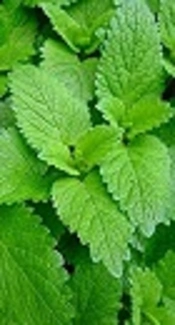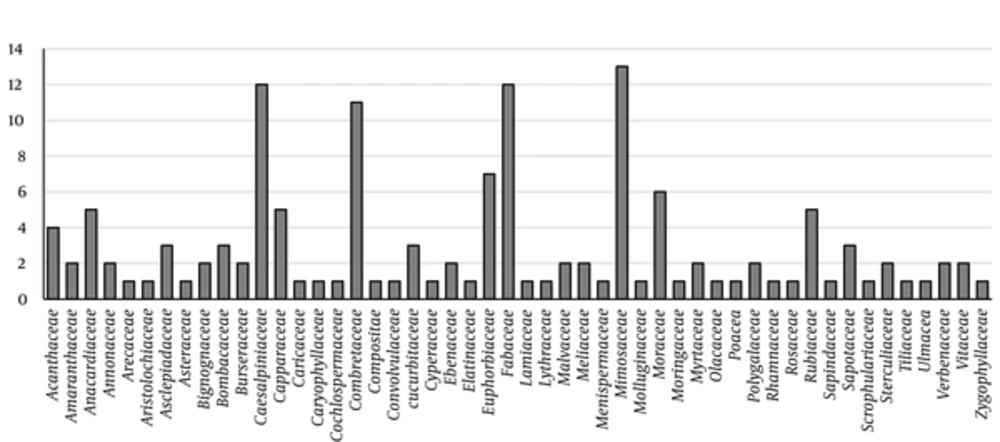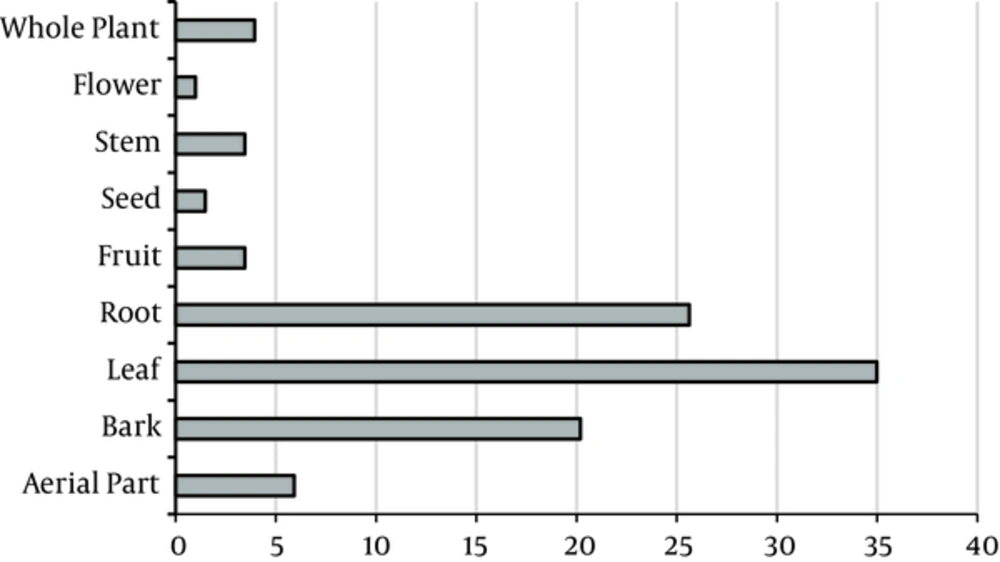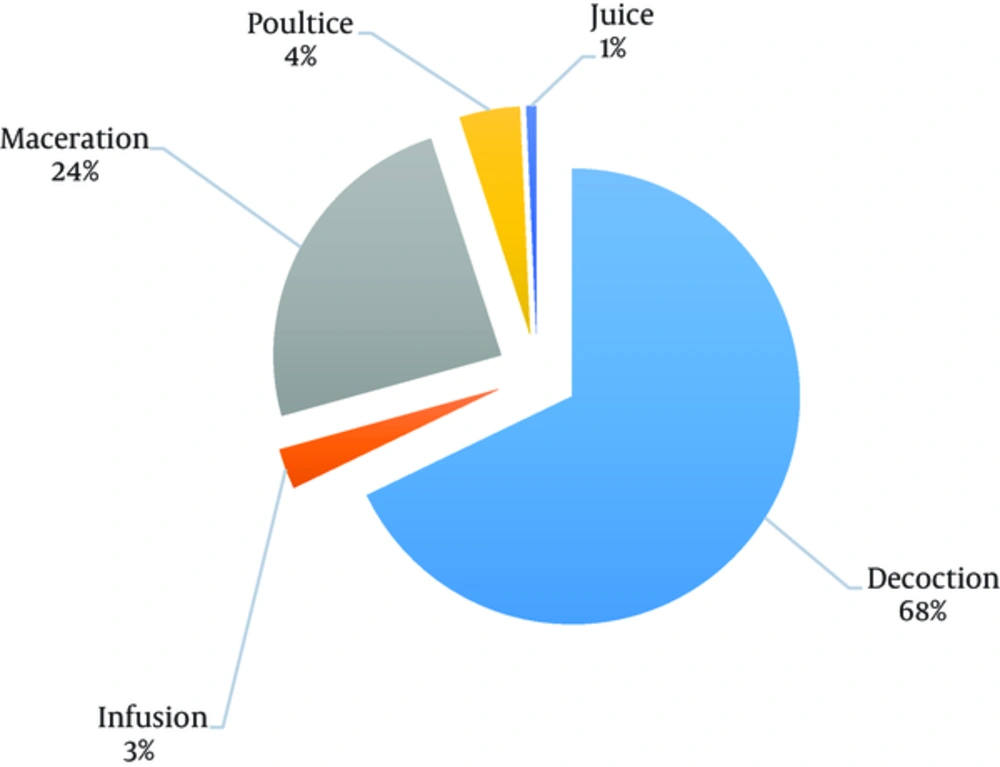1. Context
For many years, human population across the world has utilized elements of their environment, in particular, plants, to treat themselves. To date and even with the spectacular progress accomplished in the field of science, an estimate of 66% - 85% of the world’s population, especially from developing countries, depends directly on plants as medicines (1-3). The interest and the research in the field of indigenous knowledge have increased since the past years, especially after the Rio conference in 1992. In general, the most important question is how certain ethnic groups and rural local populations utilize and conserve their environment. In addition to the field of ethnobotany, it is the knowledge and diverse utilization of plants and the myths and rituals linked with (4). Medicinal plants, defined as plants having one or more bioactive compounds that could be precursors for the synthesis of useful drugs (5), and their utilization represent a partial field of ethnobotany. A significant number of developing countries, up to 80%, depend on plants to treat themselves against a variety of diseases.
Throughout the world, human population has been using the knowledge of medicinal plants to fight diseases. Africans have been using natural therapies based on herbal medicine for long and for sure amongst the oldest folk medicine currently practiced (6).
Niger, a West African country as defined by the United Nations, occupies an area of 1,267.000 km2 and is positioned between the longitudes 0° 16’ and 16° East, and the latitudes 11° 1 and 23° 17 North (7). It shares borders with Burkina Faso and Mali in the West, Algeria and Libya in the North, Chad in the East, and Nigeria and Benin in the South. Since 2002, the country has been divided administratively into 7 regions (plus the capital city Niamey) and 36 departments. The national territory covers three main climatic and ecological zones according to the latitude: Sahelian in the large north part, Sahelo-saharian in the central meridional region, and the Sahelian sub-arid in the south (8). Niger is rich in biodiversity with a flora of about 2,124 species of which, an endemic species (Rhyncosia airica) in the Air (9) is included. Additional 487 species of algae were discovered by Djima in 2013 (7), making a total of 2761 plant species.
The area of the forest is estimated to be 109,950548 hectares (10). The Niger’s fauna is also rich and diverse with about 3,200 species of animals of which, 168, 512, 150, and 112 species are mammals, birds, reptiles and amphibians, and fishes and invertebrates (such as mollusks, insects, etc.), respectively (11). Overall, in terms of the number of protected areas for the fauna, Niger disposes of seven, cumulating about 11 million hectares (14.29%) of the total national territory area (11). Consequently, traditional medicine implicating plants and/or parts of animals is a common and acceptable practice in Niger as in the other sub-Saharan countries. Many plants from the Niger flora, which have been used by the common population through traditional healers for the treatment of common diseases, have been significantly recorded and timidly investigated by competent botanists and university research groups respectively.
Dalziel (1936) (12) gave the first review on the utilization of plants in West Africa, a review enriched by Burkill (1985 - 2000) (13) in the past years. A lot of findings have been published regarding medicinal plants for the tropical zones from West Africa (14-17), and also for the other Sahelian regions of West Africa (18-20). The medicinal use of trees and shrubs in the Sahel was reported by Maydell in 1992 (21).
First studies of the medicinal plants from the Republic of Niger were published by Adam et al. (1972) (18), Adjanohoun et al. (1980) (22), and Ikhri et al. (1984) (23). Roderick (1990) (24), Arthor et al. (1992) (25), Saadou (1993) (26), Burkill (1985 - 2000) (13), and Alexander (2002) (27) provided additional information concerning medicinal plants from Niger.
Gastrointestinal disorders are health problems of significant concerns in Niger as in other least developed countries, which substantially affect worldwide morbidity and mortality rates. Diarrhea, in particular, is a leading killer of children, accounting for 9% of all deaths among children under age 5 worldwide in 2015, with over 1400 young children dying each day, or about 526,000 children a year (28). It is a common cause of death in developing countries including Niger republic and the second most common cause of infant deaths worldwide (29). In modern medicine, an important number of successful synthetic drugs across the world including Africa do exist for the treatment of gastrointestinal disorders. However, the poverty-hitting majority of the African countries have significantly encouraged most communities to reconsider phytomedicines as an alternative to survive the disease. However, these realities have encouraged and attracted many investigators to conduct interesting studies to gain more knowledge about the medicinal plants across the African countries. In a review article, Stark (2013) (30) gave an inventory of numerous plant species used as traditional remedies for painful syndromes, including conditions affecting the gastrointestinal tract in Africa. Roughly, over 150 medicinal plant species were reported for use in the treatment of painful gastrointestinal illnesses (58 families) in Africa. Olajuyigbe et al. (2012) (31) reported the usage of 36 plant species representing 24 families in the treatment of a variety of gastrointestinal disorders by the population of the Eastern Cape Province, South Africa. 47.06% and 46.15% of the plants were reported for use in the treatment of dysentery and diarrhea, respectively. In a North-West region of Madagaskar, (32) conducted a series of ethnobotanical surveys through which about 189 species of medicinal plants were recorded; 8 species were found significantly cited as anti-diarrheic agents. Semenya et al. (2012) (33) reported an important number of plants used to treat diarrhea in a survey conducted in the Limpopo Province of South Africa. Most of these plants belonged to the families Anacardiaceae, Asteraceae, Fabaceae, and Malvaceae. The Bapeli traditional healers most encouraged the use of roots, leaves, and bark to treat diarrhea. Gera et al. (2015) (34) used a total of 31 species of plants from 17 families against diarrhea, with Caesalpinaceae (17%) family being the most dominant in a survey involving Tiv people of central Nigeria. All preparations were made from single plant species using either roots, bark, stem, or leaves. The authors determined the use value of plants, a value that gives an indication of the respondents’ consensus or agreement on the efficacy of a plant. Detarium microcarpum was found with the highest use value, indicating that many of the respondents signal it as useful and efficacious.
In Niger, the numerous number of published and or non-published work in the field of ethnomedicine did mention various medicinal plant preparations and their usage locally against diverse diseases. Most of the indigenous medicinal plants from Niger cited have a significant traditional medicinal role in the treatment of gastrointestinal disorders.
One of the goals of our laboratory (key laboratory/chemistry of natural substances) in the department of applied chemistry is to document and establish knowledge bases for natural chemical substances derived from plants used in Niger’s traditional medicine.
In the present study, the ethnobotanical uses of the plant species from Niger reported elsewhere (published or not) by many investigators were reviewed and analyzed. Only plants used for the treatment of gastrointestinal disorders were considered for the purpose of this review.
2. Evidence Acquisition
Our review and analyses included all medicinal plant species known from Niger and recorded to treat gastrointestinal disorders. Indigenous information related to traditional uses of medicinal plants and/or relevant phytochemical analysis data were extracted from different studies conducted in Niger (18, 22, 23, 27, 35) as well as information from floras and their medicinal usage in Niger reported by Najada Ibrahim (2013) (36). A blind search using different search-engines (Google, Baidu, Bing, and Yahoo) and online scientific databases (HerbMed, Prelude Medicinal Plants, Kew, PubMed, Science Direct, and Google Scholar) was exploited with specific search terms such as ‘pharmacopee traditionnelle’, ‘medicinal plants’, ‘plantes du sahel’, ‘gastrointestinal’, ‘phytochemical’, ‘diarrhea’, ‘dysentery’, and ‘Niger’. A systematic and non-exhaustive library search for hard (print) copies was carried out and 5 libraries in total were visited.
We considered 7 categories of gastrointestinal disorders namely: diarrhea, dysentery, hemorrhoid, intestinal worms, constipation, stomachache, and abdominal bloating.
We counted the number of species used to treat gastrointestinal disorders and grouped them with respect to the family they belong to. The collected information was inputted into an Excel database for analysis.
To rank the plant species according to their contributions or usefulness, the number of references citing the use of a species and the number of use categories per species were applied to calculate relative importance index. The RI was calculated as follows (37, 38):
RI = (max (RFC) + max (RNU))/2
Where: RFC = relative frequency of citation (Frequency of citation/Number of References), RNU = Relative number of use-categories (Number of uses/Maximum number of uses of a species).
3. Results
3.1. Ethnomedicinal Review of Plants
A total of 140 indigenous medicinal plants belonging to 50 families were reported in the literature as being used by the Nigerien population to treat different gastrointestinal disorders. Most of the reported medicinal plant species belong to the family Mimosaceae (13 species), followed by Fabaceae (12 species), Caesalpiniaceae (12 species), and Combretaceae (11 species) (Figure 1). The percentage of medicinal plants used to treat the category of the gastrointestinal disorder is represented in Figure 2. Diarrhea (25%) and stomachache (25%) appeared to be the most targeted affections followed by dysentery (19%) and hemorrhoid (18%). Out of these 140 indigenous medicinal plants, 20 were individually evaluated and found highly valuable according to the relative importance index, thus categorized as ‘top used’ plant species (Table 1).
3.2. Plant Part Used, Method of Preparation and Route of Administration
The plant part usage for the treatment of digestive system diseases and disorders has concerned leaves, bark, root, fruit, stem, seed, aerial part, and the whole plant. The leaves (35%), root (26%), and bark (20%) were cited the most frequently used parts (Figure 3).
Plant parts collected were prepared in different forms with decoction (95 (68%)) as the most frequently recommended form followed by maceration (24%), poultice (4%), infusion (3%), and juice (1%) (Figure 4).
The route of administration of the herbal medicines was diverse. About 90% of the recorded indigenous medicinal plants were administered as portion orally and the others to either be eaten as food, used for a seat bath, or chewed in the mouth.
3.3. Phytochemical Composition of Selected Plants
Phytochemical analysis data were available for only 11 of the top-20 species.
Table 1 shows chemical constituents discovered in different plant species. 55% - 70% of the studied plants were found to contain tannins, steroids, terpenoids, and alkaloids while only 35% contained saponins or quinolones.
4. Conclusions
In this review, 20 medicinal plants out of 140 used for the treatment of diarrhea, dysentery, constipation, stomachache, hemorrhoid, intestinal worm, and abdominal bloating were reported as the most useful. 80% of these plants from Niger to treat gastrointestinal disorders were also utilized for the same purpose in other sub-Saharan countries including Mali (39), Benin Republic (17), Togo (40), Ivory Coast (41), Nigeria (34, 42), and Burkina Faso (37).
Amongst the different plant species reported to target different gastrointestinal disorders, diarrhea, stomachache, and dysentery were found with the highest percentages of plant species recorded (25%, 25%, and 19%, respectively). This consideration might explain the fact that diarrhea first constitutes a significant burden for most rural communities of Niger. Majority of them had very limited living conditions that may contribute, in consequence, to the development or rapid spread of diarrhea across the community.
Different plant parts are used for the preparation of the traditional herbal remedy destined to treat a given gastrointestinal disorders and leaves appeared with the highest prevalence of use as the most used part of plants in this study. Many other studies conducted elsewhere including the neighboring countries also showed the prevalence of the leaves in the preparation of traditional herbal remedies (43-46). Methods of preparing herbal remedies were diverse with decoction and maceration as the most reported methods in this review. Decoction, a method of preparation which includes phytochemicals extraction of active substances through boiling of a part or combination of different parts, could be more effective (31).
The relative importance index was determined for each plant species in this study and the respective values obtained were used to rank the plant species (Table 1). The highest recorded RI values (0.70 - 0.84) indicated the best level of importance of the plant species for use in treating gastrointestinal disorders. Seven plant species out of the top-20 shown in Table 1 (Lannea acida, Acacia nilotica, Balanites aegyptiaca, Bauhinia rufescens, Boswellia dalzielli, Combretum micranthum, and Ziziphus mauritiana) were identified as very useful plants. Ranking plant species through a valid statistical approach is an important prerequisite and strategy to identify the best ones for future conservation planning (37, 47).
In Niger, a few investigators have reported on the major bioactive constituents of the plants used in gastrointestinal disorders. In the present review, 11 plant species were reported (Table 1) to include one or more chemical constituent(s) that could affect gastrointestinal disorders as anti-diarrheic, anti-dysenteric, anti-inflammatory, stomachic, purgative, etc.
Baoua et al. (35), Nassirou et al. (48), and Ikhiri et al. (23) have reported the presence of chemical constituents in the selected plants. Most of the studied plants (6 to 8 species) were found rich in tannins, terpenoids, steroids, and alkaloids. Antidiarrheal, antidysenteric, and anthelmintic properties of medicinal plants were found to be due to the presence of tannins, alkaloids, saponins, flavonoids, steroids, and terpenoids (Cowan, 1999 (49); Palombo, 2006 (50); Pandey et al. (2013) (51). The same authors have reported that these secondary metabolites listed above including others have antimicrobial properties against large groups of microorganisms.
4.1. Conclusion
The literature review of medicinal plants from Niger showed that 140 species of plants were used for the treatment of gastrointestinal disorders, among which 20 were the most valuable. A few (or almost none) of these plant species have been the subject of advanced pharmacological studies to verify or confirm their potential as veritable candidate therapeutic agents. However, a lot remains to be done in further investigations for the better valorization of the medicinal plants from Niger. All the referential documents for the ethnomedicinal surveys conducted in Niger reviewed were limited to traditional pharmacopoeia of Niger. However, the extension of the bibliographic literature review recruiting those from other sub-Sahara West African regions should be considered in future in order to enrich and provide possibilities for comparison of the pharmacopoeia from different countries.
| Scientific Name | Family | Local Name of Plant | Habit | Part Used | Preparation | Traditional Therapeutic Application | Relative Importance Index (RI) | References | Known Chemical Constituents |
|---|---|---|---|---|---|---|---|---|---|
| Lannea acida A. Rich. | Anacardiaceae | Faru (H), Faru (B) | Shrub | Bark, leaf | Decoction | Dysentery, Intestinal worm, hemorrhoid, stomachache, constipation, abdominal bloating | 0.84 | (18, 22, 23, 27, 36) | NA |
| Acacia nilotica L. | Mimosaceae | Bagaruwa (H), Baan (Z), Gawari (P), Kangar (B), Tiggaert (T) | Herb | Root, leaf | Decoction | Diarrhea, dysentery, Hemorrhoid, stomachache, Constipation | 0.75 | (18, 22, 23, 27, 36) | Tannin, terpenoids, steroids (35) |
| Balanites aegyptiaca (L.) Del. | Zygophyllaceae | Aduwa (H), Garbeye (Z), Tanni (P), Biito (B), Aboragh (T) | Tree | Bark, root, seed | Decoction, maceration | Diarrhea, dysentery, intestinal worm, stomachache, constipation | 0.74 | (18, 22, 23, 27, 36) | NA |
| Bauhinia rufescens Lam. | Caesalpiniaceae | Dirga (H), Namari (Z), Namare (P), Shishim (B), Taedaeyni (T) | Shrub | Bark, leaf | Decoction, poultice | Diarrhea, dysentery, hemorrhoid, stomachache | 0.74 | (18, 23, 27, 35, 52) | Flavonoids, tannins, terpenoids, steroids (35) |
| Boswellia dalzielli Hutch. | Burseraceae | Hano (H), Hano (Z), Andokehi (P), Kafi dukan (B) | Tree | Bark, root, leaf | Decoction or maceration | Diarrhea, dysentery, intestinal worm, hemorrhoid, stomachache | 0.74 | (22, 23, 27, 35, 36) | Flavonoids, tannins, terpenoids, steroids, Quinones (35) |
| Combretum micranthum G. Don. | Combretaceae | Geza (H), Kubu (Z), Talli (P), Geza (B), Dagera (T) | Shrub | Leaf | Maceration | Diarrhea, dysentery, hemorrhoid, stomachache | 0.70 | (18, 22, 23, 27, 36) | Alkaloids (23) |
| Ziziphus mauritiana Lam. | Rhamnaceae | Magariya (H), Darey (Z), Djabhi (P), Kasulu (B), Abakat (T) | Shrub | Root, leaf | Maceration, decoction | Diarrhea, dysentery, hemorrhoid, stomachache | 0.70 | (18, 22, 23, 27, 36) | Alkaloids, saponins, tannins, terpenoids, steroids (35) |
| Combretum aculeatum Vent. | Combretaceae | Bubukia (H), Bubure (Z), Bulapal (P), Buka-buki (T) | Tree | Aerial parts, leaf | Decoction | Dysentery, intestinal worm, hemorrhoid | 0.63 | (18, 22, 23, 27, 35) | NA |
| Detarium microcarpum Guill. and Perr | Caesalpiniaceae | Taura (H), Fantu (Z), Kukehy (P) | Tree | bark, root | Decoction, maceration | Diarrhea, dysentery, hemorrhoid, stomachache | 0.62 | (23, 27, 35, 36) | Flavonoids, saponins, tannins, terpenoids, steroids, Quinones (48) |
| Sclerocarya birrea (A. Rich.) Hochst | Anacardiaceae | Dania (H), Daney (Z), Hedi (P), Koma (B), Tuwila (T) | Tree | Whole plant | Decoction, poultice | Diarrhea, dysentery, hemorrhoid, stomachache | 0.62 | (18, 22, 23, 27) | Flavonoids, tannins, terpenoids, steroids (35) |
| Ximenia americana L. | Olacaceae | Tsada (H), Kumhu (Z), Ciabuli (P), Dadin (B), | Small tree | Root, leaf | Maceration | Dysentery, hemorrhoid, stomachache, abdominal bloating | 0.62 | (22, 23, 27, 36) | Alkaloids (23); Flavonoids, saponins, tannins, terpenoids, steroids, Quinones (48) |
| Pterocarpus erinaceus (Poir.) | Fabaceae | Madobia (H), Tolo (Z), Banuki (P), Tahivasa (B) | Tree | Root | Maceration | Diarrhea, dysentery, intestinal worm, hemorrhoid, stomachache | 0.61 | (23, 27, 35, 36) | NA |
| Khaya senegalensis (Desv.) | Meliaceae | Madoci (H), Kahi (Z) | Tree | Bark, root, leaf | Decoction | Diarrhea, hemorrhoid, stomachache | 0.55 | (22, 23, 27, 36) | NA |
| Prosopis africana (R. Br.) Guill and Perr. | Mimosaceae | Kiriya (H), Zam turi (Z), Kohy (P) | Tree | Bark, root, leaf | Decoction | Dysentery, hemorrhoid, stomachache | 0.54 | (22, 23, 27, 36) | Alkaloids (23, 48); Flavonoids, saponins, tannins, terpenoids, steroids, Quinones (48) |
| Parinari macrophylla sabine. | Rosaceae | Gawasa (H), Gamsa (Z), Nawudi (P) | Tree | Bark, root, leaf | Decoction | Diarrhea, dysentery, hemorrhoid, stomachache | 0.54 | (23, 27, 36) | NA |
| Piliostigma reticulatum DC. | Caesalpiniaceae | Kalgo (H), Kosorey (Z), M’barkehi (P), Kalul (B), Hadugu (T) | Tree | Root, leaf | Decoction | Diarrhea, hemorrhoid, stomachache, abdominal bloating | 0.54 | (22, 23, 27) | NA |
| Annona senegalensis Pers. var. | Annonaceae | Gwanda (H), Mufa (Z), N’dukuhi (P), Tisa (B) | Shrub | Bark, root, leaf | Decoction | Diarrhea, hemorrhoid, stomachache, constipation | 0.53 | (22, 27, 36) | Alkaloids (23) |
| Guiera senegalensis I.F. Gmel. | Combretaceae | Sabara (H), Sabara (Z), Jelokhy (P), Kasasi (B), Tuwila (T) | Shrub | Bark, leaf | Decoction | Diarrhea, dysentery, hemorrhoid, stomachache | 0.53 | (23, 27, 36) | Alkaloids (23) |
| Cassia sieberiana DC. | Caesalpiniaceae | Malga (H), Sinesan (Z), Gama fahdahi (P) | Tree | Root | Maceration or decoction | Diarrhea, hemorrhoid, stomachache, constipation | 0.50 | (23, 27, 36) | NA |
| Combretum nigricans var. elliotii (Engl. and Diels) Aubrev. | Combretaceae | Tsiriri (H), Deli (Z), Buiki (P), Dagara (T) | Shrub | Root, leaf, stem | Decoction, maceration | Diarrhea, hemorrhoid, stomachache, constipation | 0.50 | (23, 27, 36) | NA |
The Best Useful Plant Species for the Treatment of Gastrointestinal Disorders in Niger Based on the Relative Importance Index




